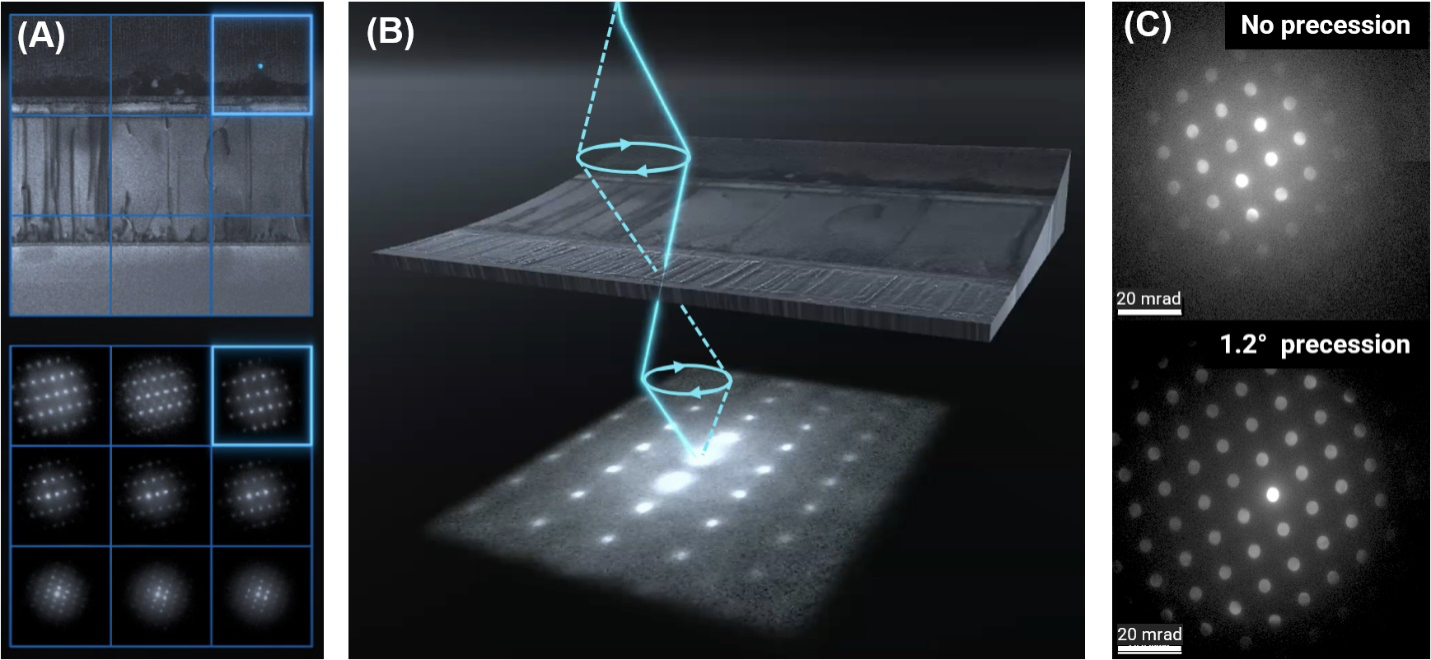
Precession-Assisted 4D-STEM Mapping Insights
PRESENTING THE NANO-WORLD WITH PRECISION AND CLARITY
TESCAN GROUP proudly presents a breakthrough in nanoscale analysis: the integration of precession-assisted 4D-STEM phase and orientation mapping with synchronized EDX signals on our TESCAN TENSOR. This innovative approach, spearheaded by our experts, marks a significant leap forward in characterising complex materials and semiconductor devices.
This unique solution developed by TESCAN significantly advances phase mapping capabilities in polycrystalline materials at the nanoscale. Our latest innovation merges the synchronous collection of 4D-STEM data with EDX signals, culminating in unprecedented accuracy in differentiating phases with similar structures. This breakthrough ensures precise segmentation and quantitative characterization of even the most challenging phases.
Discover more and download the Application Note.

Figure 1: (A) Acquisition of a 4D-STEM dataset with the sample image shown above and recorded diffraction patterns from individual pixels depicted below. (B) Schematics of 4D-STEM data acquisition with beam precession (blue line) during recording of a single diffraction pattern. (C) Improvement of 4D-STEM data with 1.2° beam precession: increased peak to background intensity ratio, more uniform intensity distribution within diffraction spots, and excitation of higher angle Bragg spots.
Key Features of Precession-Assisted 4D STEM for Nano-Scale Imaging:
Precession-Assisted 4D-STEM:
Our groundbreaking precession-assisted TESCAN TENSOR 4D STEM technology propels electron microscopy into a new era. By scanning a focused electron beam across a sample and collecting intricate diffraction patterns, we reveal comprehensive details about crystal structures defects and orientation.
EDX Signals:
This integration of EDX allows us to detect the unique X-rays emitted within the sample. When combined with 4D-STEM data, this feature provides a deeper understanding of the chemical composition of various phases.
Seamless Integration:
The TESCAN TENSOR’s capability to simultaneously acquire 4D-STEM and EDX data facilitates a holistic analysis of a material’s structural organization and chemical composition. This integrated approach is pivotal in characterizing complex samples with precision.
Applications:
Metallurgists and materials processing engineers specializing in advanced alloys or ceramics will discover the immense benefits of our solution. This innovation is also invaluable in semiconductor process development, offering the ability to discern crystallographic information from different phases in intricate device architectures.
Imagine the power to differentiate between multiple similar phases, each with its distinct crystal structure. The TESCAN TENSOR’s multimodal analytical capabilities make this a reality, enabling you to identify phases with nearly identical lattice parameters. This tool is indispensable for those analyzing ceramics, alloys, or nanomaterials, providing the insights needed to make informed decisions.
Thank you for Your interest.
Further Insights:

